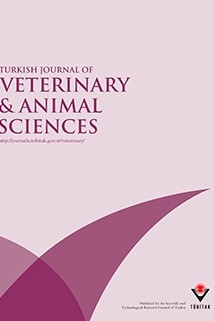
Turkish Journal of Veterinary and Animal Sciences
Yazarlar: Ö. Hakan MUĞLALI
Konular:-
Anahtar Kelimeler:Force feeding,Fatty liver,Hepatic enzymes
Özet: This study was carried out to determine the effect of force feeding on the fattening performance, fatty liver production and some blood parameters of adult geese. The level of cholesterol, triglyceride, HDL and LDL in plasma lipids and the hepatic enzymes SGOT, SGPT and ALP were analysed during different periods of the study. While the initial plasma lipid fractions, cholesterol, triglyceride, HDL and LDL, of the control group, group I and group II were 245.42 ± 16.79, 370.14 ± 31.42, 61.42 ± 6.37 and 11.90 ± 1.90; 233.85 ± 8.54, 374.85 ± 37.98, 61.57 ± 4.38 and 10.42 ± 2.22; and 236.78 ± 13.69, 372.40 ± 33.53, 61.37 ± 4.93 and 11.00 ± 1.66 mg/dl, they had increased 262.85 ± 16.13, 373.00 ± 30.22, 55.42 ± 7.98 and 10.85 ± 2.15; 592.57 ± 106.78, 2064.71 ± 300.65, 180.42 ± 10.80 and 90.57 ± 10.61; and 956.50 ± 146.13, 3831.50 ± 250.49, 247.50 ± 18.25 and 177.00 ± 21.09 mg/dl by the end of the cramming period (P < 0.001). Increased enzyme levels of SGOT, SGPT and ALP were accompanied by hepatic tissue destruction. Enzyme levels of SGOT, SGPT and ALP were approximately 7.7, 3.6, 4.6 and 9.7, 5.6, 4.9 fold higher in groups I and II, respectively, than in the control group. Lauric, myristic, stearic, palmitic, oleic, lynoleic and arachidonic acid contents of liver samples of both groups of force-fed birds were statistically significant compared with the control group (P < 0.001). Dry matter, crude protein, ether extract and crude ash contents of liver samples were 30.74 ± 0.384, 17.22 ± 1.117, 7.11 ± 0.383 and 1.24 ± 0.032% in the control group whereas they were 38.59 ± 1.378, 13.40 ± 0.387, 27.75 ± 2.318 and 0.85 ± 0.099%; and 44.65 ± 0.408, 11.25 ± 0.306, 42.39 ± 1.508 and 0.81 ± 0.038% in groups I and II, respectively (P < 0.001). Although crude protein and crude ash content decreased, dry matter content increased along with by ether extract content in the liver samples of groups I and II. At slaughter, the average liver weight of the control group was 60.50 ± 2.16 g, whereas it was 121.66 ± 10.15 and 170.41 ± 15.94 g in groups I and II, respectively. In conclusion, Turkish geese are not suitable for fatty liver production.